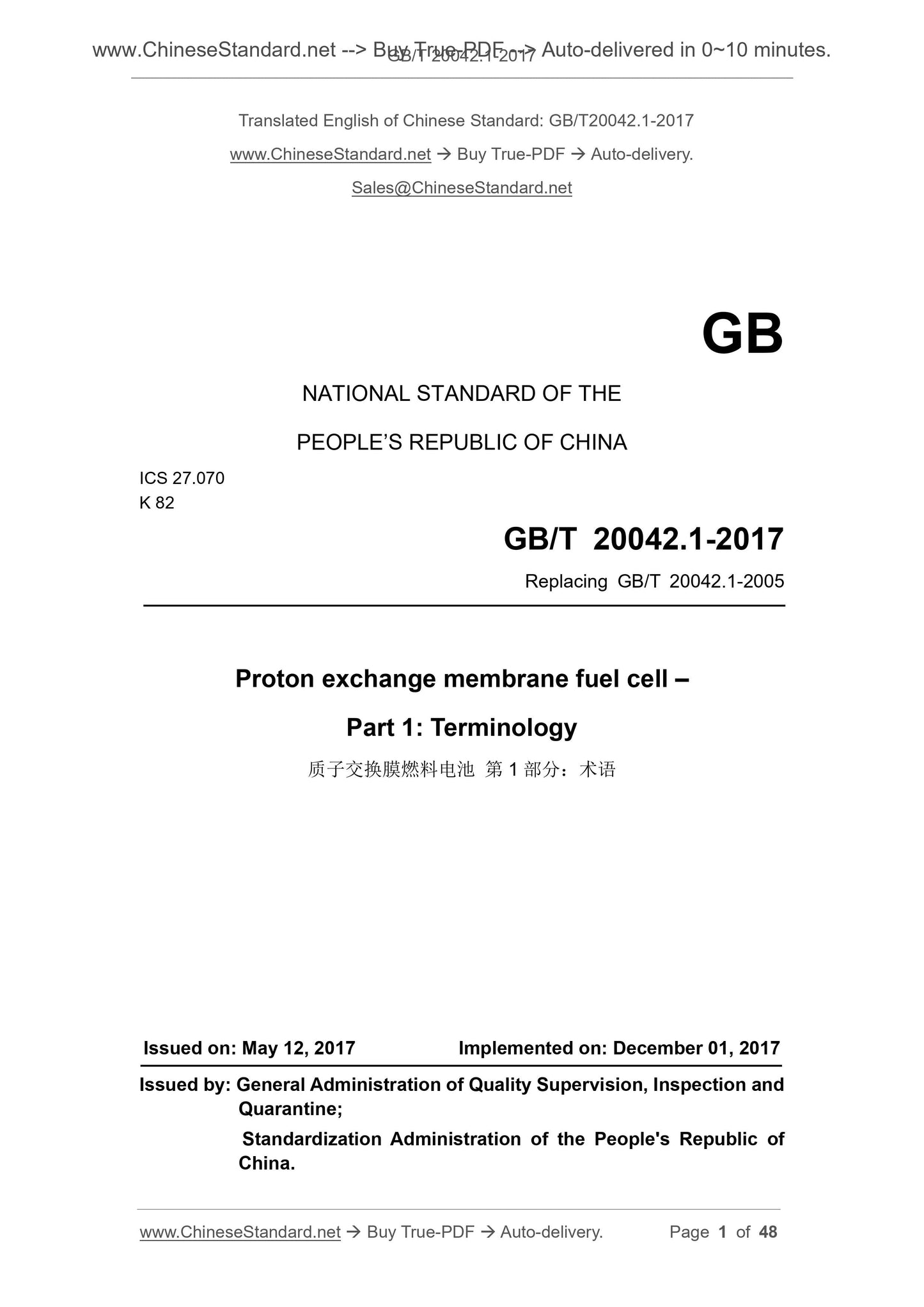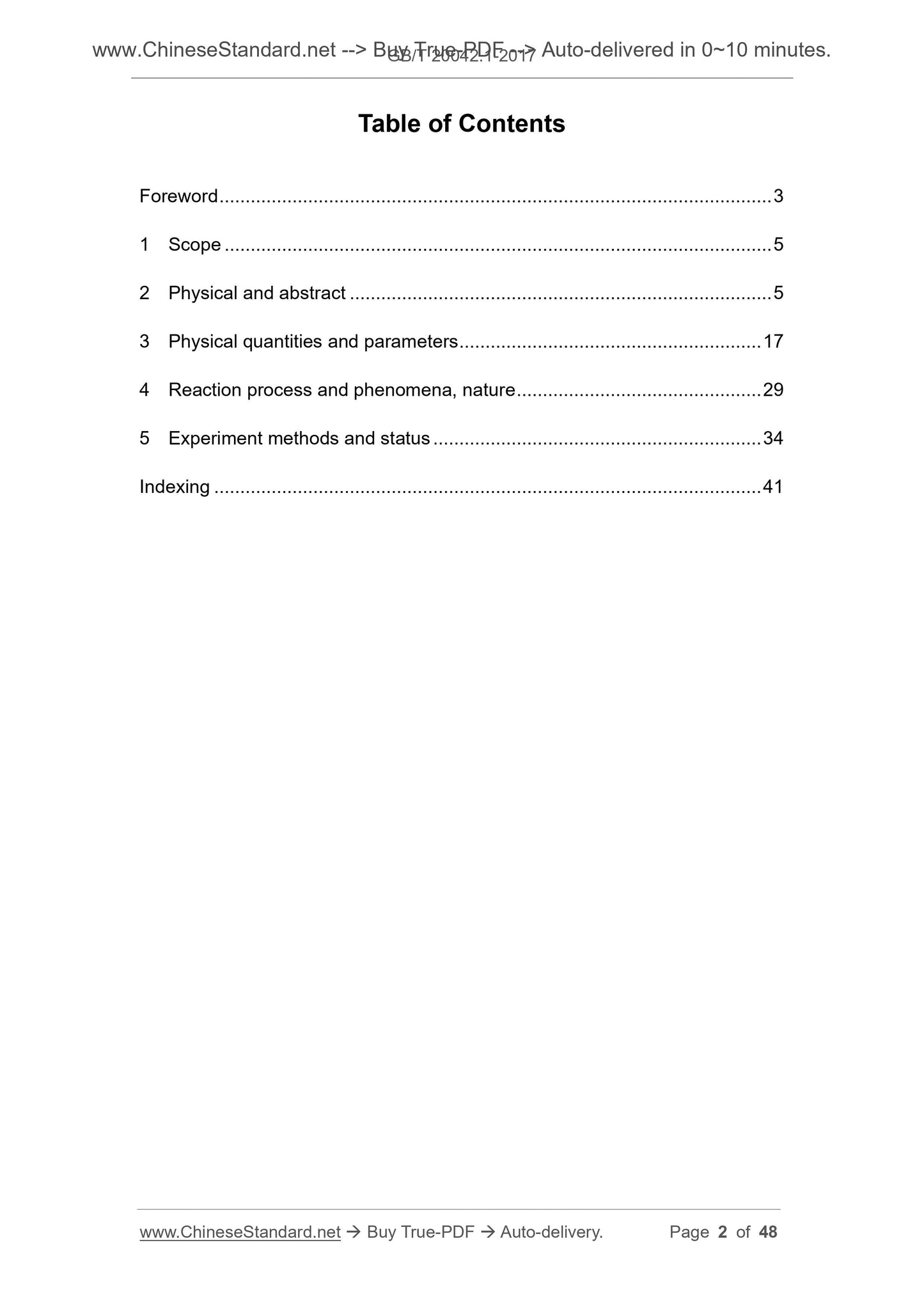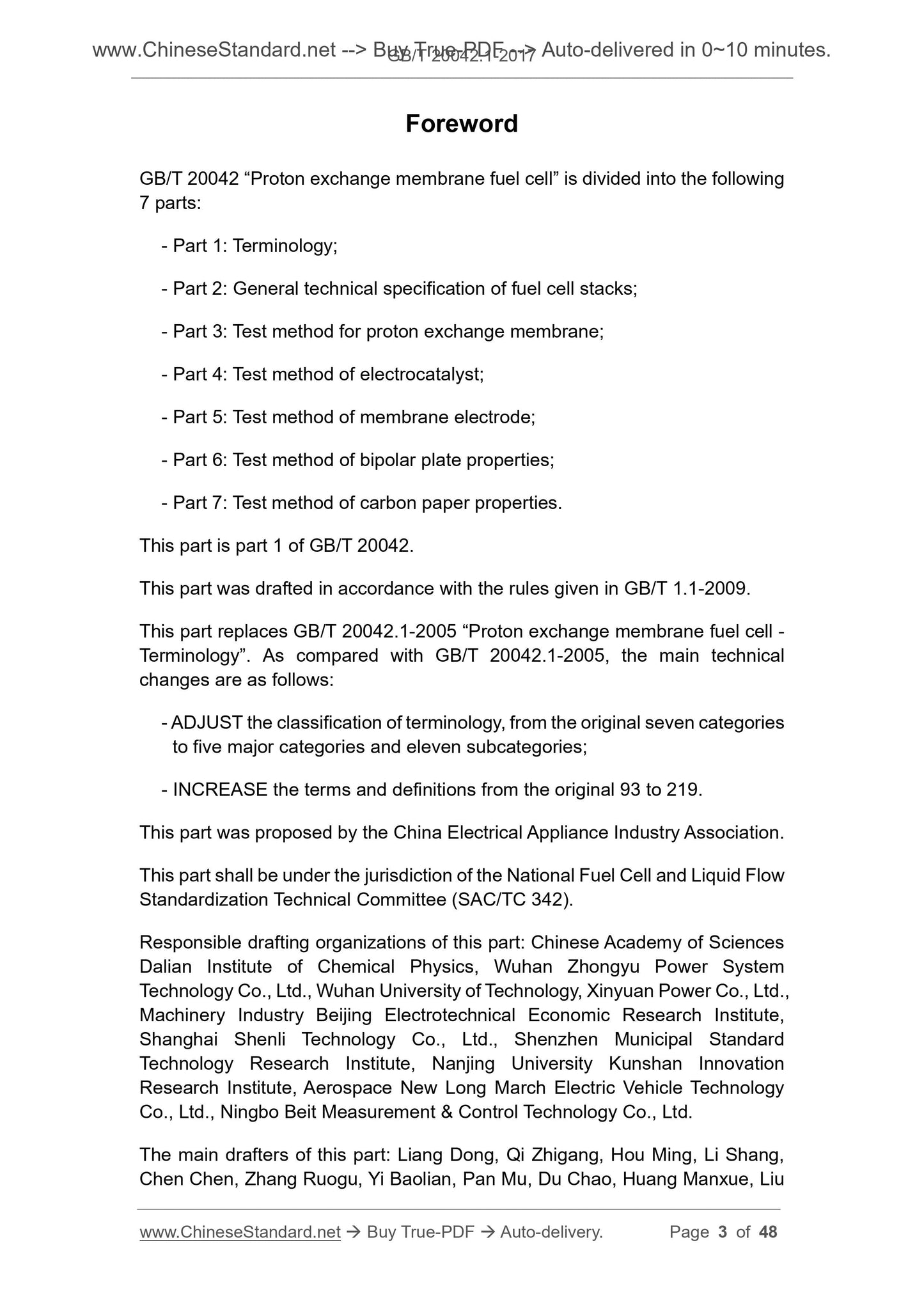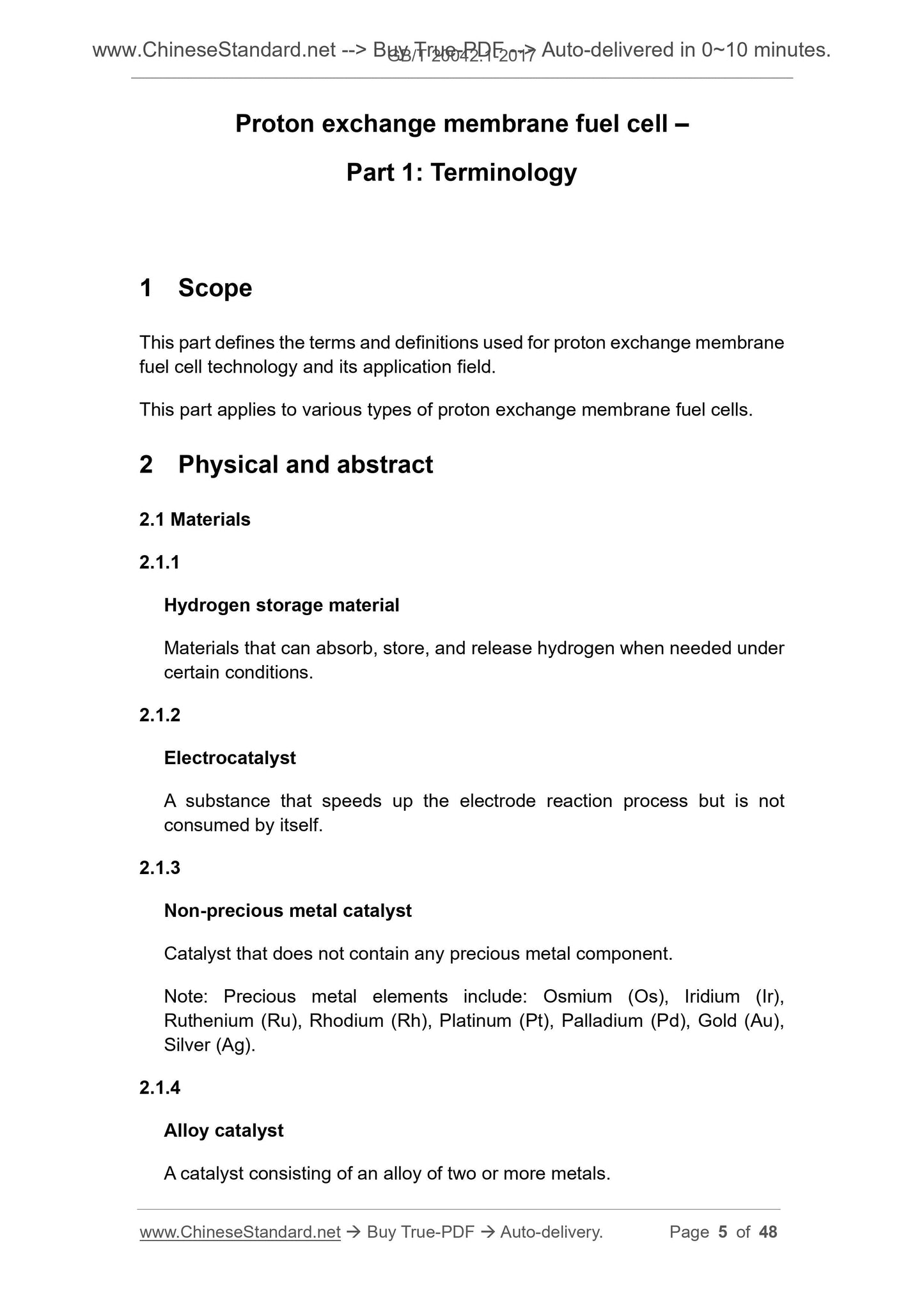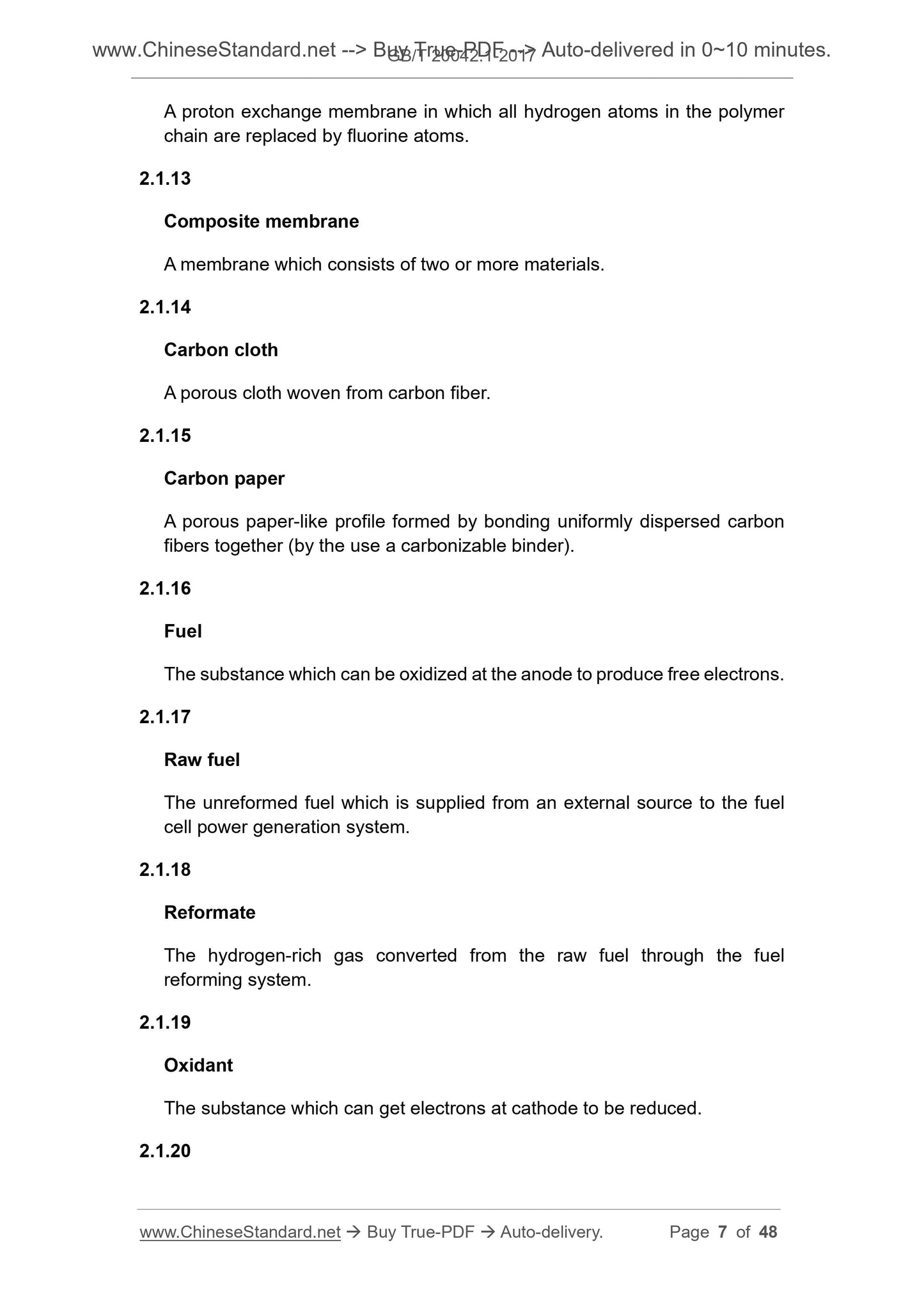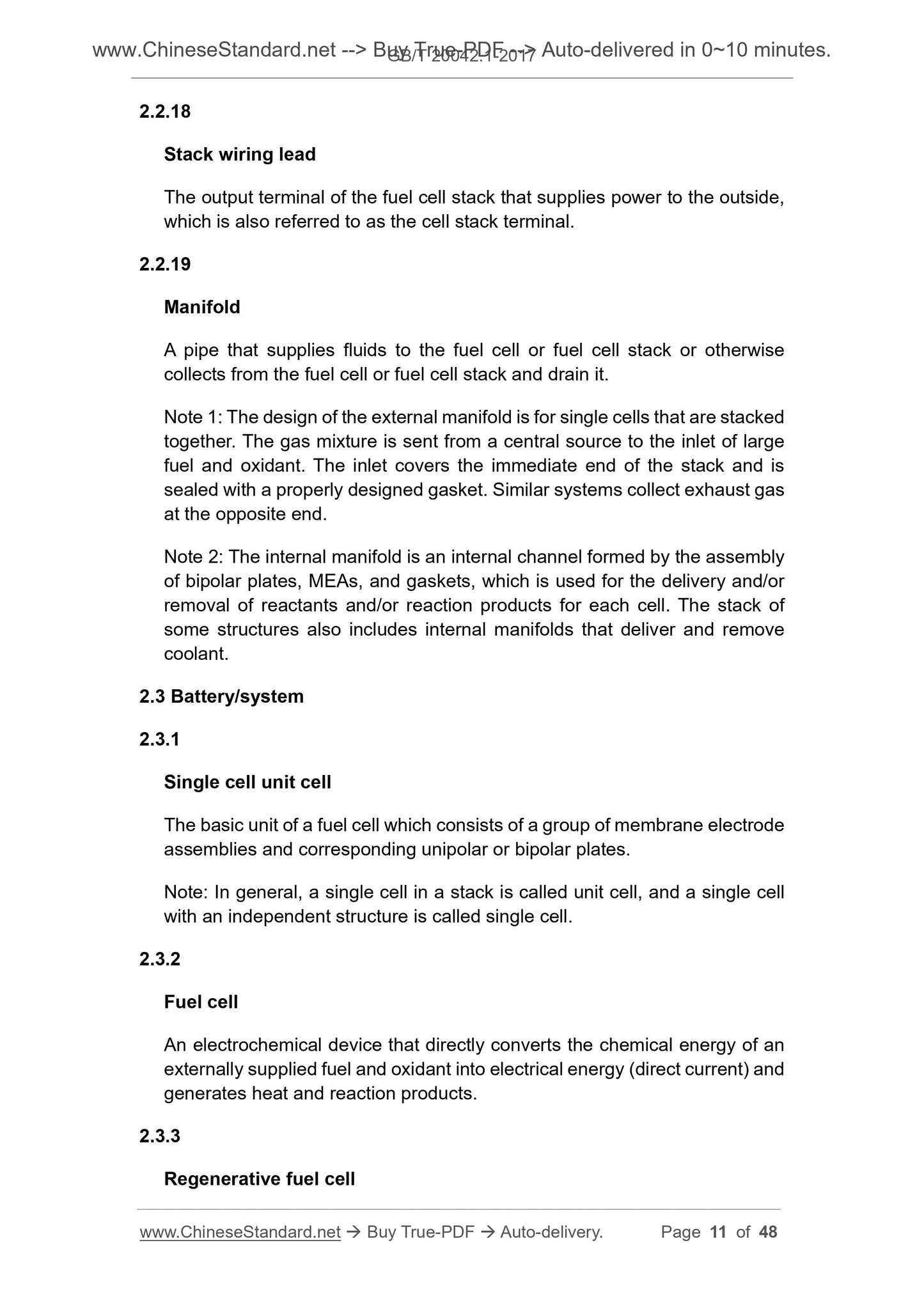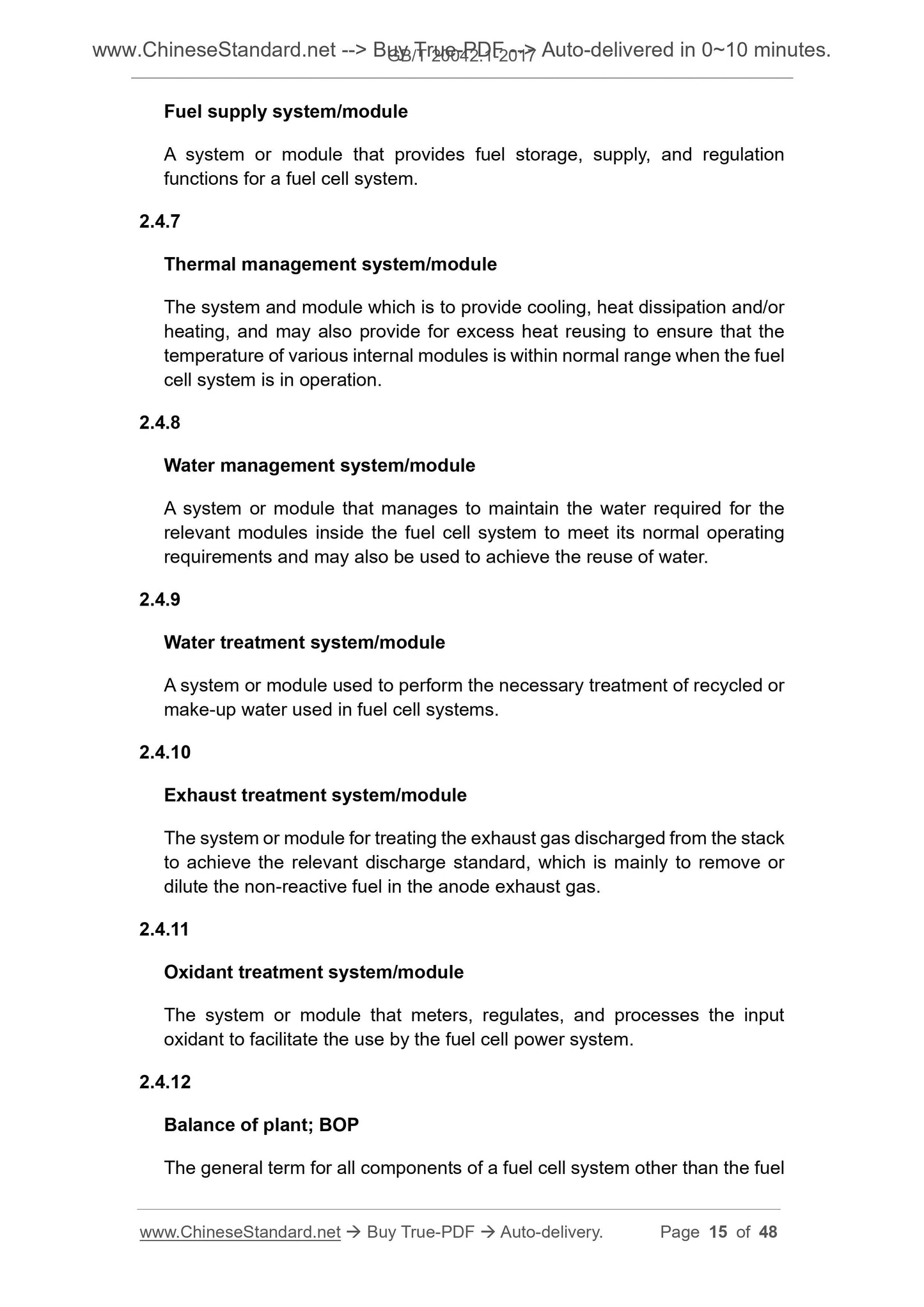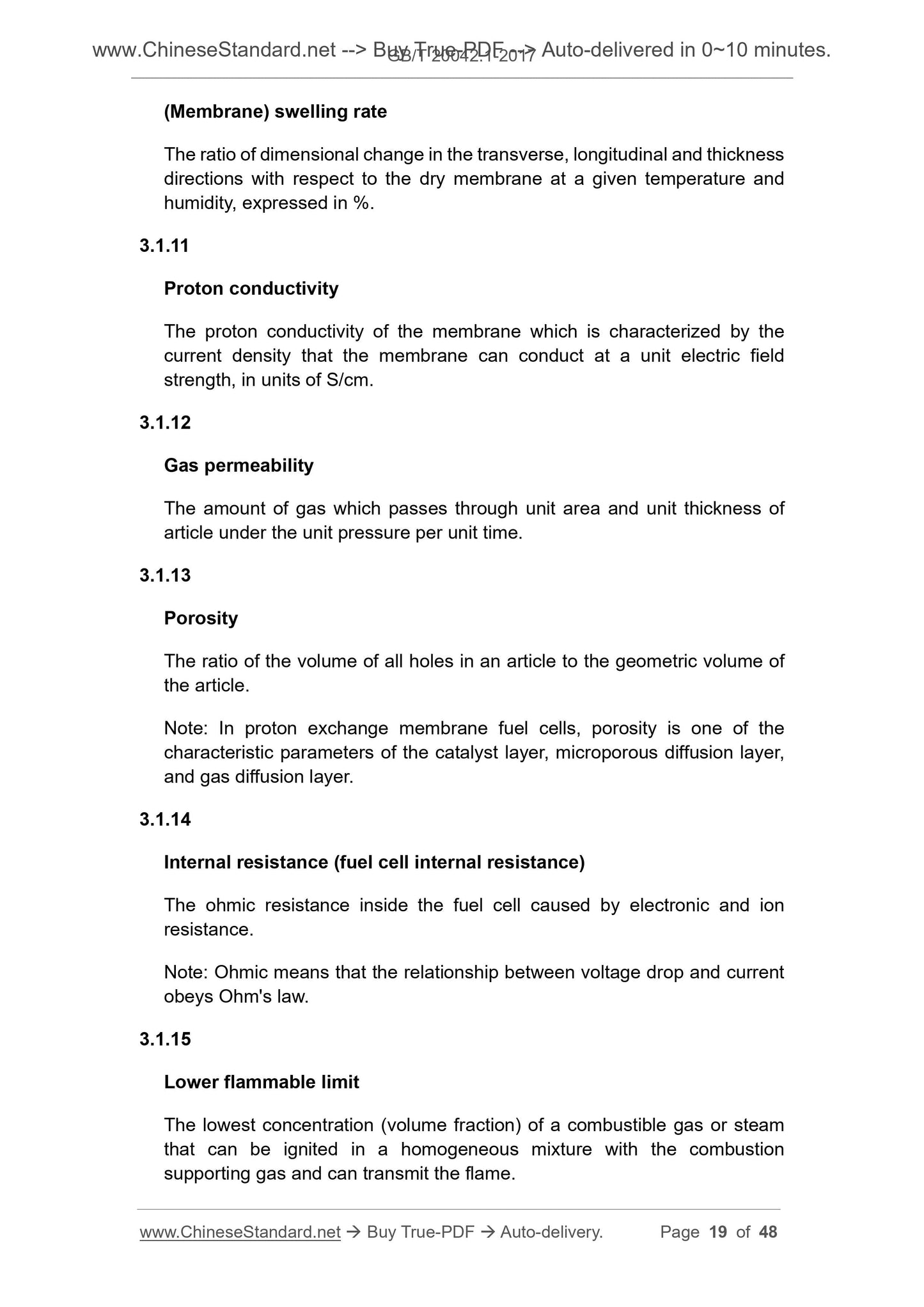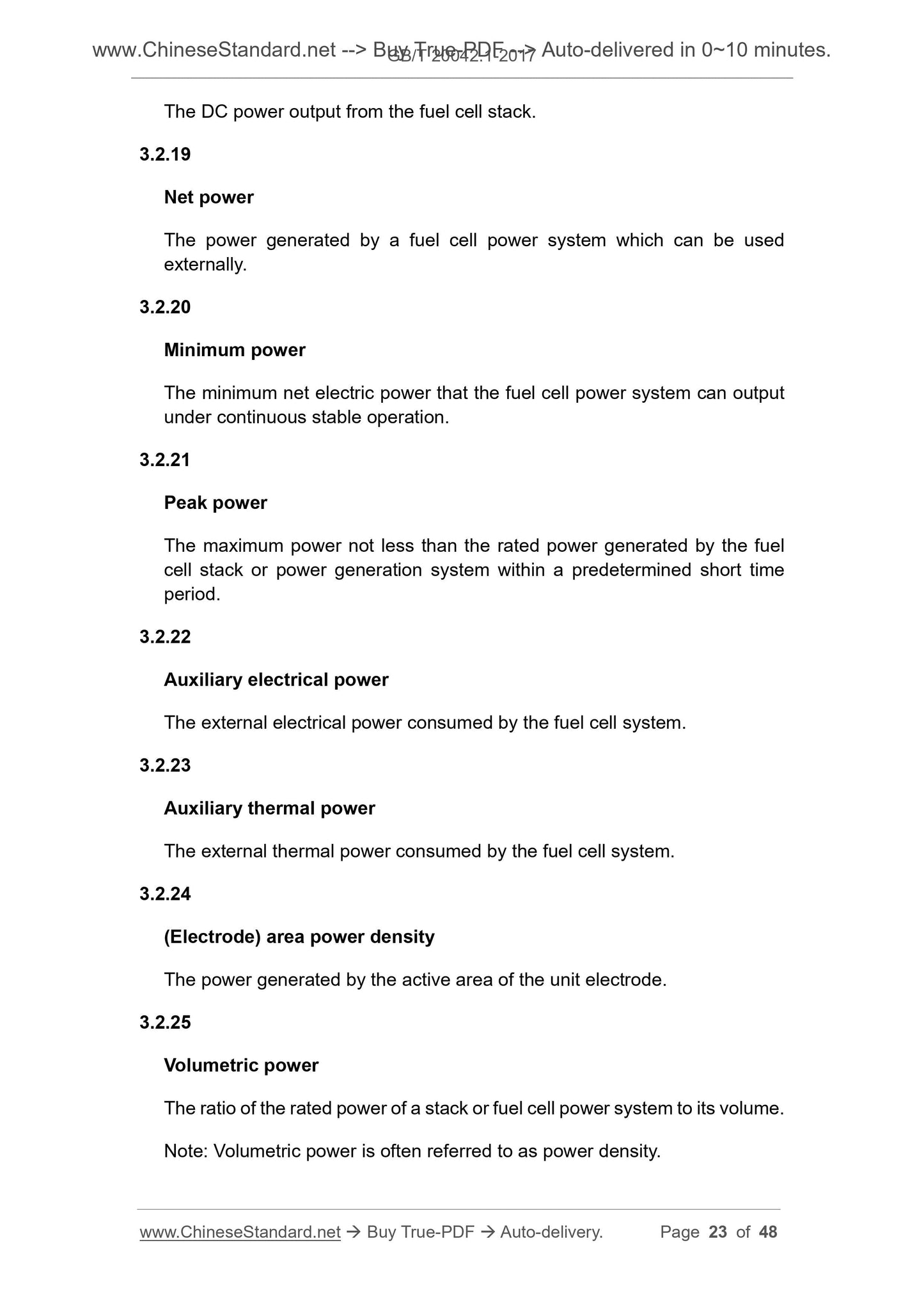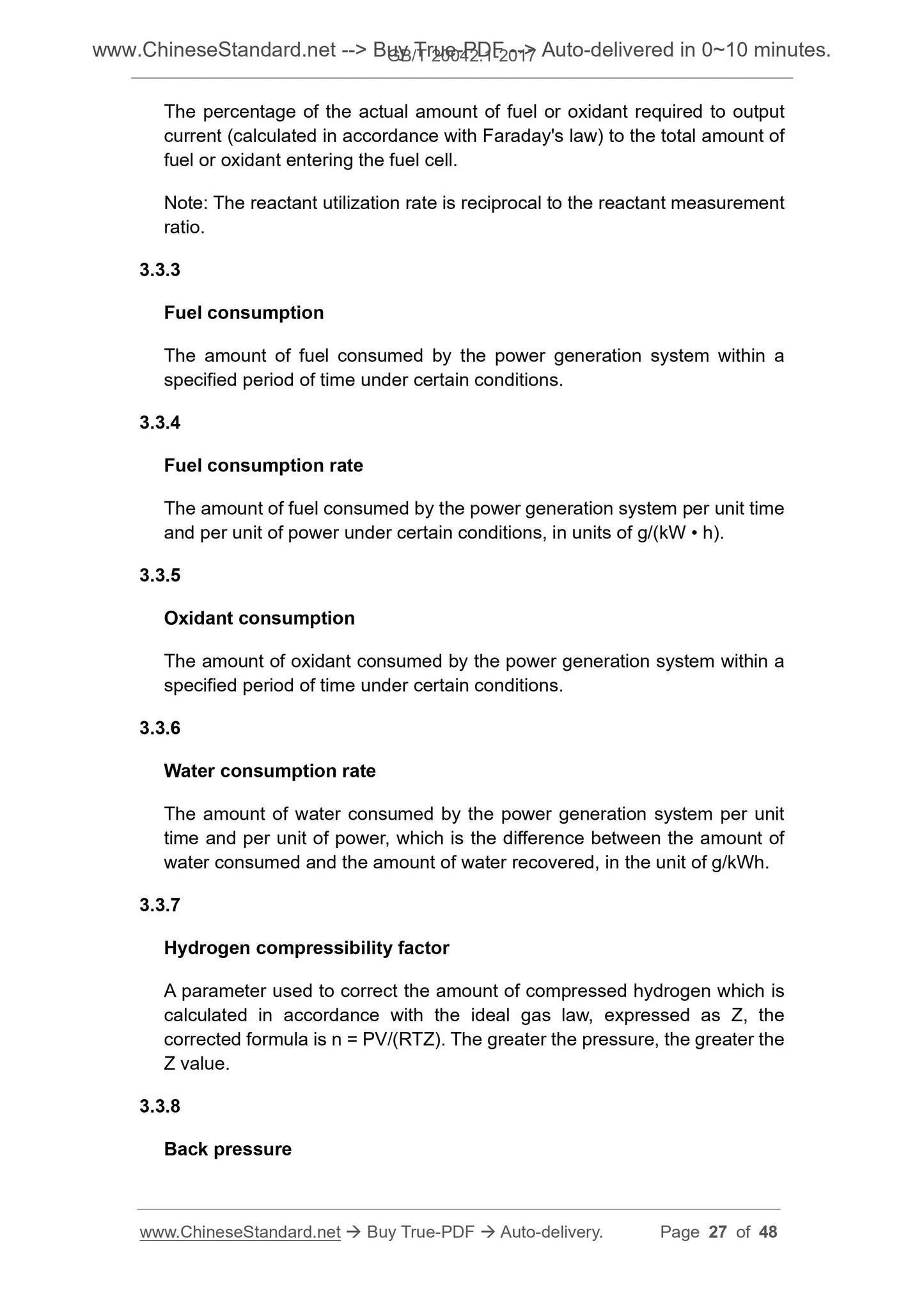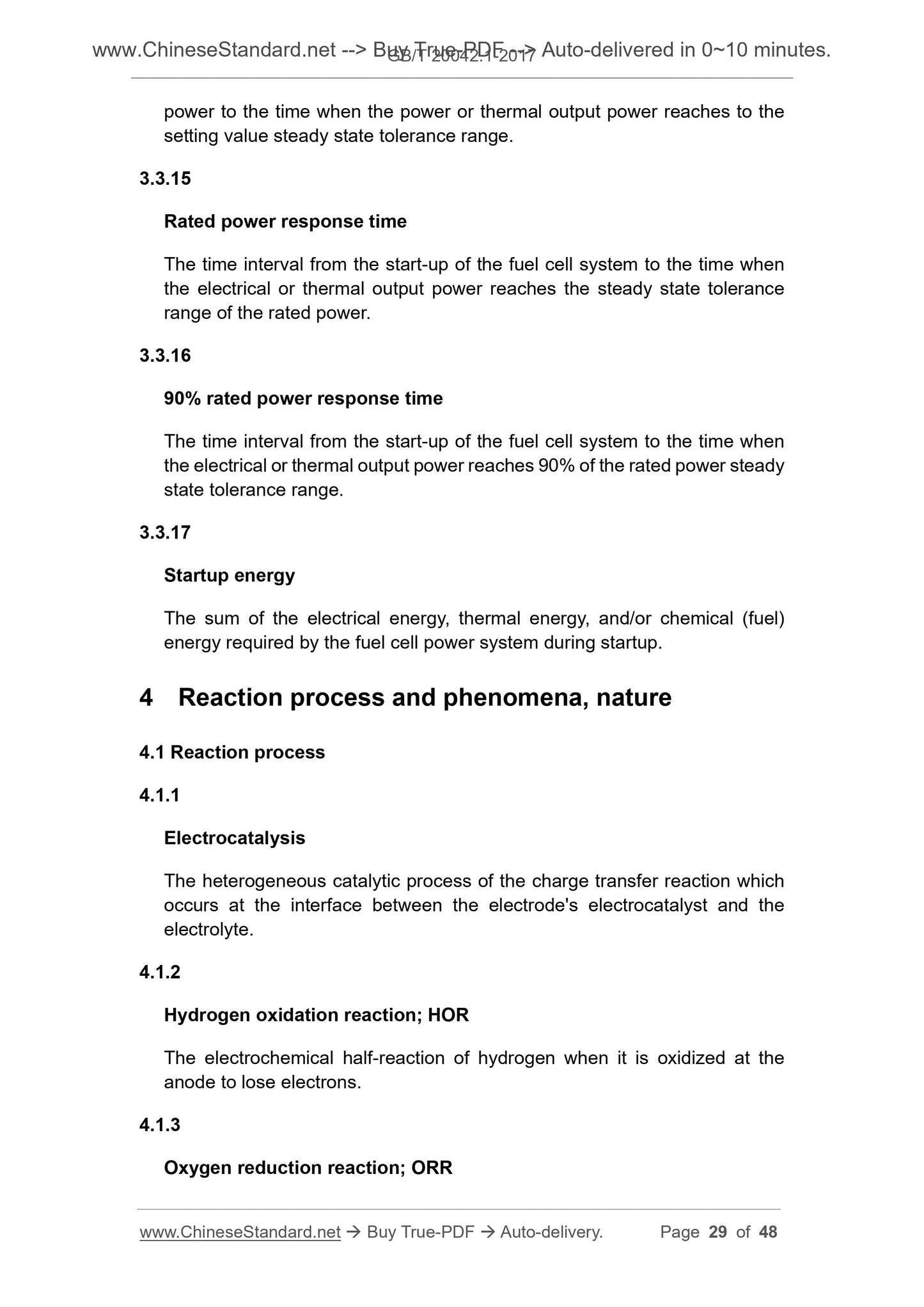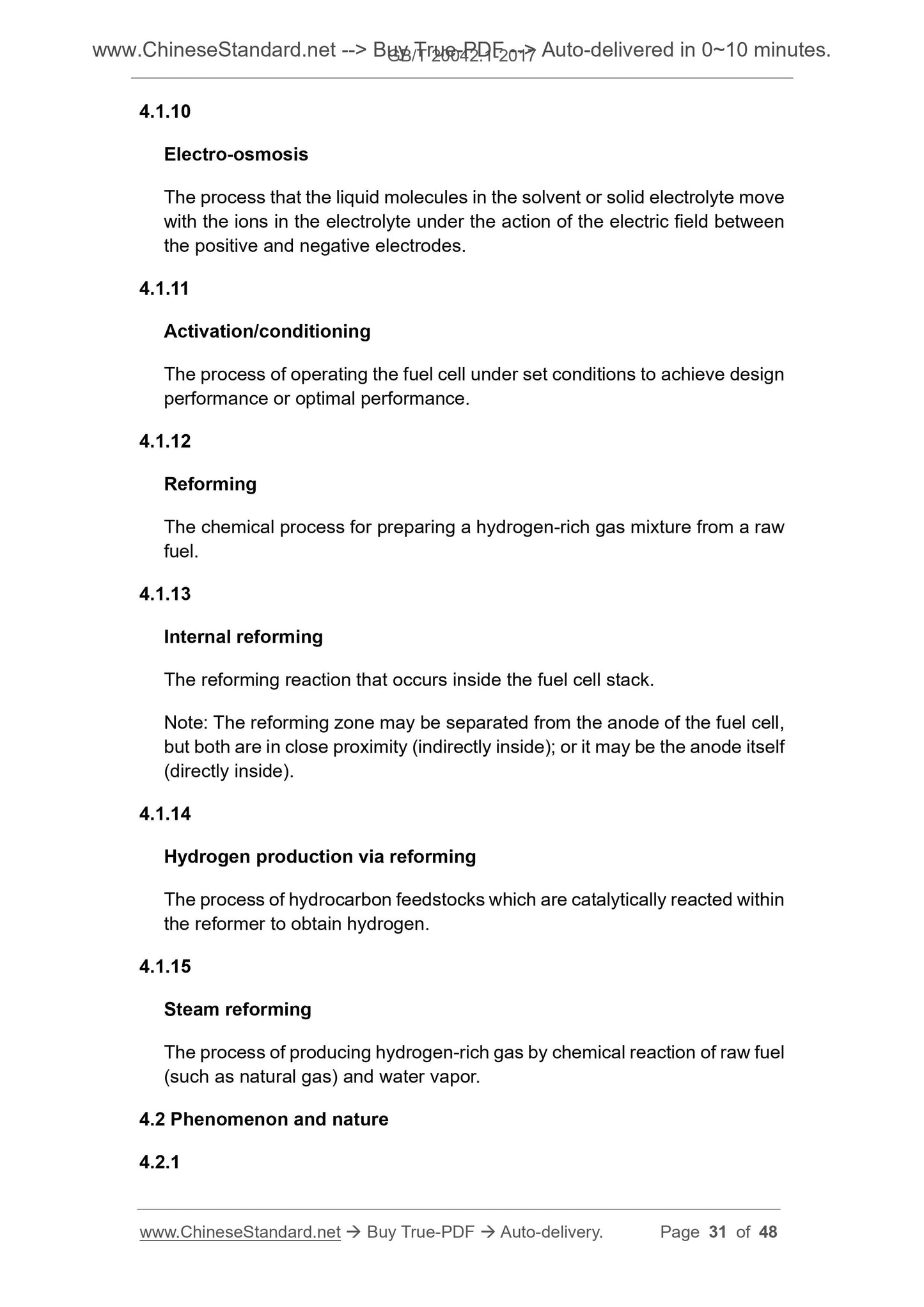1
/
of
12
PayPal, credit cards. Download editable-PDF & invoice in 1 second!
GB/T 20042.1-2017 English PDF (GBT20042.1-2017)
GB/T 20042.1-2017 English PDF (GBT20042.1-2017)
Regular price
$145.00 USD
Regular price
Sale price
$145.00 USD
Unit price
/
per
Shipping calculated at checkout.
Couldn't load pickup availability
Delivery: 3 seconds. Download true-PDF + Invoice.
Get QUOTATION in 1-minute: Click GB/T 20042.1-2017
Historical versions: GB/T 20042.1-2017
Preview True-PDF (Reload/Scroll if blank)
GB/T 20042.1-2017: Proton exchange membrane fuel cell -- Part 1: Terminology
GB/T 20042.1-2017
GB
NATIONAL STANDARD OF THE
PEOPLE’S REPUBLIC OF CHINA
ICS 27.070
K 82
Replacing GB/T 20042.1-2005
Proton exchange membrane fuel cell –
Part 1. Terminology
ISSUED ON. MAY 12, 2017
IMPLEMENTED ON. DECEMBER 01, 2017
Issued by. General Administration of Quality Supervision, Inspection and
Quarantine;
Standardization Administration of the People's Republic of
China.
Table of Contents
Foreword . 3
1 Scope .. 5
2 Physical and abstract . 5
3 Physical quantities and parameters . 17
4 Reaction process and phenomena, nature . 29
5 Experiment methods and status . 34
Indexing .. 41
Foreword
GB/T 20042 “Proton exchange membrane fuel cell” is divided into the following
7 parts.
- Part 1. Terminology;
- Part 2. General technical specification of fuel cell stacks;
- Part 3. Test method for proton exchange membrane;
- Part 4. Test method of electrocatalyst;
- Part 5. Test method of membrane electrode;
- Part 6. Test method of bipolar plate properties;
- Part 7. Test method of carbon paper properties.
This part is part 1 of GB/T 20042.
This part was drafted in accordance with the rules given in GB/T 1.1-2009.
This part replaces GB/T 20042.1-2005 “Proton exchange membrane fuel cell -
Terminology”. As compared with GB/T 20042.1-2005, the main technical
changes are as follows.
- ADJUST the classification of terminology, from the original seven categories
to five major categories and eleven subcategories;
- INCREASE the terms and definitions from the original 93 to 219.
This part was proposed by the China Electrical Appliance Industry Association.
This part shall be under the jurisdiction of the National Fuel Cell and Liquid Flow
Standardization Technical Committee (SAC/TC 342).
Responsible drafting organizations of this part. Chinese Academy of Sciences
Dalian Institute of Chemical Physics, Wuhan Zhongyu Power System
Technology Co., Ltd., Wuhan University of Technology, Xinyuan Power Co., Ltd.,
Machinery Industry Beijing Electrotechnical Economic Research Institute,
Shanghai Shenli Technology Co., Ltd., Shenzhen Municipal Standard
Technology Research Institute, Nanjing University Kunshan Innovation
Research Institute, Aerospace New Long March Electric Vehicle Technology
Co., Ltd., Ningbo Beit Measurement and Control Technology Co., Ltd.
The main drafters of this part. Liang Dong, Qi Zhigang, Hou Ming, Li Shang,
Chen Chen, Zhang Ruogu, Yi Baolian, Pan Mu, Du Chao, Huang Manxue, Liu
Proton exchange membrane fuel cell –
Part 1. Terminology
1 Scope
This part defines the terms and definitions used for proton exchange membrane
fuel cell technology and its application field.
This part applies to various types of proton exchange membrane fuel cells.
2 Physical and abstract
2.1 Materials
2.1.1
Hydrogen storage material
Materials that can absorb, store, and release hydrogen when needed under
certain conditions.
2.1.2
Electrocatalyst
A substance that speeds up the electrode reaction process but is not
consumed by itself.
2.1.3
Non-precious metal catalyst
Catalyst that does not contain any precious metal component.
Note. Precious metal elements include. Osmium (Os), Iridium (Ir),
Ruthenium (Ru), Rhodium (Rh), Platinum (Pt), Palladium (Pd), Gold (Au),
Silver (Ag).
2.1.4
Alloy catalyst
A catalyst consisting of an alloy of two or more metals.
A proton exchange membrane in which all hydrogen atoms in the polymer
chain are replaced by fluorine atoms.
2.1.13
Composite membrane
A membrane which consists of two or more materials.
2.1.14
Carbon cloth
A porous cloth woven from carbon fiber.
2.1.15
Carbon paper
A porous paper-like profile formed by bonding uniformly dispersed carbon
fibers together (by the use a carbonizable binder).
2.1.16
Fuel
The substance which can be oxidized at the anode to produce free electrons.
2.1.17
Raw fuel
The unreformed fuel which is supplied from an external source to the fuel
cell power generation system.
2.1.18
Reformate
The hydrogen-rich gas converted from the raw fuel through the fuel
reforming system.
2.1.19
Oxidant
The substance which can get electrons at cathode to be reduced.
2.1.20
2.2.18
Stack wiring lead
The output terminal of the fuel cell stack that supplies power to the outside,
which is also referred to as the cell stack terminal.
2.2.19
Manifold
A pipe that supplies fluids to the fuel cell or fuel cell stack or otherwise
collects from the fuel cell or fuel cell stack and drain it.
Note 1. The design of the external manifold is for single cells that are stacked
together. The gas mixture is sent from a central source to the inlet of large
fuel and oxidant. The inlet covers the immediate end of the stack and is
sealed with a properly designed gasket. Similar systems collect exhaust gas
at the opposite end.
Note 2. The internal manifold is an internal channel formed by the assembly
of bipolar plates, MEAs, and gaskets, which is used for the delivery and/or
removal of reactants and/or reaction products for each cell. The stack of
some structures also includes internal manifolds that deliver and remove
coolant.
2.3 Battery/system
2.3.1
Single cell unit cell
The basic unit of a fuel cell which consists of a group of membrane electrode
assemblies and corresponding unipolar or bipolar plates.
Note. In general, a single cell in a stack is called unit cell, and a single cell
with an independent structure is called single cell.
2.3.2
Fuel cell
An electrochemical device that directly converts the chemical energy of an
externally supplied fuel and oxidant into electrical energy (direct current) and
generates heat and reaction products.
2.3.3
Regenerative fuel cell
Fuel supply system/module
A system or module that provides fuel storage, supply, and regulation
functions for a fuel cell system.
2.4.7
Thermal management system/module
The system and module which is to provide cooling, heat dissipation and/or
heating, and may also provide for excess heat reusing to ensure that the
temperature of various internal modules is within normal range when the fuel
cell system is in operation.
2.4.8
Water management system/module
A system or module that manages to maintain the water required for the
relevant modules inside the fuel cell system to meet its normal operating
requirements and may also be used to achieve the reuse of water.
2.4.9
Water treatment system/module
A system or module used to perform the necessary treatment of recycled or
make-up water used in fuel cell systems.
2.4.10
Exhaust treatment system/module
The system or module for treating the exhaust gas discharged from the stack
to achieve the relevant discharge standard, which is mainly to remove or
dilute the non-reactive fuel in the anode exhaust gas.
2.4.11
Oxidant treatment system/module
The system or module that meters, regulates, and processes the input
oxidant to facilitate the use by the fuel cell power system.
2.4.12
Balance of plant; BOP
The general term for all components of a fuel cell system other than the fuel
(Membrane) swelling rate
The ratio of dimensional change in the transverse, longitudinal and thickness
directions with respect to the dry membrane at a given temperature and
humidity, expressed in %.
3.1.11
Proton...
Get QUOTATION in 1-minute: Click GB/T 20042.1-2017
Historical versions: GB/T 20042.1-2017
Preview True-PDF (Reload/Scroll if blank)
GB/T 20042.1-2017: Proton exchange membrane fuel cell -- Part 1: Terminology
GB/T 20042.1-2017
GB
NATIONAL STANDARD OF THE
PEOPLE’S REPUBLIC OF CHINA
ICS 27.070
K 82
Replacing GB/T 20042.1-2005
Proton exchange membrane fuel cell –
Part 1. Terminology
ISSUED ON. MAY 12, 2017
IMPLEMENTED ON. DECEMBER 01, 2017
Issued by. General Administration of Quality Supervision, Inspection and
Quarantine;
Standardization Administration of the People's Republic of
China.
Table of Contents
Foreword . 3
1 Scope .. 5
2 Physical and abstract . 5
3 Physical quantities and parameters . 17
4 Reaction process and phenomena, nature . 29
5 Experiment methods and status . 34
Indexing .. 41
Foreword
GB/T 20042 “Proton exchange membrane fuel cell” is divided into the following
7 parts.
- Part 1. Terminology;
- Part 2. General technical specification of fuel cell stacks;
- Part 3. Test method for proton exchange membrane;
- Part 4. Test method of electrocatalyst;
- Part 5. Test method of membrane electrode;
- Part 6. Test method of bipolar plate properties;
- Part 7. Test method of carbon paper properties.
This part is part 1 of GB/T 20042.
This part was drafted in accordance with the rules given in GB/T 1.1-2009.
This part replaces GB/T 20042.1-2005 “Proton exchange membrane fuel cell -
Terminology”. As compared with GB/T 20042.1-2005, the main technical
changes are as follows.
- ADJUST the classification of terminology, from the original seven categories
to five major categories and eleven subcategories;
- INCREASE the terms and definitions from the original 93 to 219.
This part was proposed by the China Electrical Appliance Industry Association.
This part shall be under the jurisdiction of the National Fuel Cell and Liquid Flow
Standardization Technical Committee (SAC/TC 342).
Responsible drafting organizations of this part. Chinese Academy of Sciences
Dalian Institute of Chemical Physics, Wuhan Zhongyu Power System
Technology Co., Ltd., Wuhan University of Technology, Xinyuan Power Co., Ltd.,
Machinery Industry Beijing Electrotechnical Economic Research Institute,
Shanghai Shenli Technology Co., Ltd., Shenzhen Municipal Standard
Technology Research Institute, Nanjing University Kunshan Innovation
Research Institute, Aerospace New Long March Electric Vehicle Technology
Co., Ltd., Ningbo Beit Measurement and Control Technology Co., Ltd.
The main drafters of this part. Liang Dong, Qi Zhigang, Hou Ming, Li Shang,
Chen Chen, Zhang Ruogu, Yi Baolian, Pan Mu, Du Chao, Huang Manxue, Liu
Proton exchange membrane fuel cell –
Part 1. Terminology
1 Scope
This part defines the terms and definitions used for proton exchange membrane
fuel cell technology and its application field.
This part applies to various types of proton exchange membrane fuel cells.
2 Physical and abstract
2.1 Materials
2.1.1
Hydrogen storage material
Materials that can absorb, store, and release hydrogen when needed under
certain conditions.
2.1.2
Electrocatalyst
A substance that speeds up the electrode reaction process but is not
consumed by itself.
2.1.3
Non-precious metal catalyst
Catalyst that does not contain any precious metal component.
Note. Precious metal elements include. Osmium (Os), Iridium (Ir),
Ruthenium (Ru), Rhodium (Rh), Platinum (Pt), Palladium (Pd), Gold (Au),
Silver (Ag).
2.1.4
Alloy catalyst
A catalyst consisting of an alloy of two or more metals.
A proton exchange membrane in which all hydrogen atoms in the polymer
chain are replaced by fluorine atoms.
2.1.13
Composite membrane
A membrane which consists of two or more materials.
2.1.14
Carbon cloth
A porous cloth woven from carbon fiber.
2.1.15
Carbon paper
A porous paper-like profile formed by bonding uniformly dispersed carbon
fibers together (by the use a carbonizable binder).
2.1.16
Fuel
The substance which can be oxidized at the anode to produce free electrons.
2.1.17
Raw fuel
The unreformed fuel which is supplied from an external source to the fuel
cell power generation system.
2.1.18
Reformate
The hydrogen-rich gas converted from the raw fuel through the fuel
reforming system.
2.1.19
Oxidant
The substance which can get electrons at cathode to be reduced.
2.1.20
2.2.18
Stack wiring lead
The output terminal of the fuel cell stack that supplies power to the outside,
which is also referred to as the cell stack terminal.
2.2.19
Manifold
A pipe that supplies fluids to the fuel cell or fuel cell stack or otherwise
collects from the fuel cell or fuel cell stack and drain it.
Note 1. The design of the external manifold is for single cells that are stacked
together. The gas mixture is sent from a central source to the inlet of large
fuel and oxidant. The inlet covers the immediate end of the stack and is
sealed with a properly designed gasket. Similar systems collect exhaust gas
at the opposite end.
Note 2. The internal manifold is an internal channel formed by the assembly
of bipolar plates, MEAs, and gaskets, which is used for the delivery and/or
removal of reactants and/or reaction products for each cell. The stack of
some structures also includes internal manifolds that deliver and remove
coolant.
2.3 Battery/system
2.3.1
Single cell unit cell
The basic unit of a fuel cell which consists of a group of membrane electrode
assemblies and corresponding unipolar or bipolar plates.
Note. In general, a single cell in a stack is called unit cell, and a single cell
with an independent structure is called single cell.
2.3.2
Fuel cell
An electrochemical device that directly converts the chemical energy of an
externally supplied fuel and oxidant into electrical energy (direct current) and
generates heat and reaction products.
2.3.3
Regenerative fuel cell
Fuel supply system/module
A system or module that provides fuel storage, supply, and regulation
functions for a fuel cell system.
2.4.7
Thermal management system/module
The system and module which is to provide cooling, heat dissipation and/or
heating, and may also provide for excess heat reusing to ensure that the
temperature of various internal modules is within normal range when the fuel
cell system is in operation.
2.4.8
Water management system/module
A system or module that manages to maintain the water required for the
relevant modules inside the fuel cell system to meet its normal operating
requirements and may also be used to achieve the reuse of water.
2.4.9
Water treatment system/module
A system or module used to perform the necessary treatment of recycled or
make-up water used in fuel cell systems.
2.4.10
Exhaust treatment system/module
The system or module for treating the exhaust gas discharged from the stack
to achieve the relevant discharge standard, which is mainly to remove or
dilute the non-reactive fuel in the anode exhaust gas.
2.4.11
Oxidant treatment system/module
The system or module that meters, regulates, and processes the input
oxidant to facilitate the use by the fuel cell power system.
2.4.12
Balance of plant; BOP
The general term for all components of a fuel cell system other than the fuel
(Membrane) swelling rate
The ratio of dimensional change in the transverse, longitudinal and thickness
directions with respect to the dry membrane at a given temperature and
humidity, expressed in %.
3.1.11
Proton...
Share
